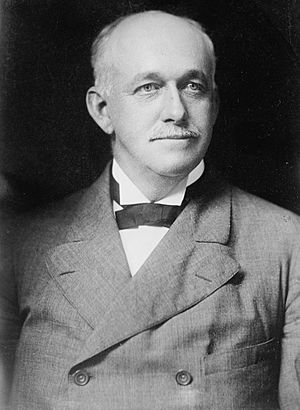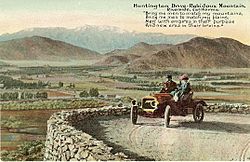Henry E. Huntington facts for kids
Quick facts for kids
Henry E. Huntington
|
|
|---|---|
 |
|
| Born |
Henry Edwards Huntington
February 27, 1850 Oneonta, New York, U.S.
|
| Died | May 23, 1927 (aged 77) Philadelphia, Pennsylvania, U.S.
|
| Spouse(s) | Mary Alice Prentice Arabella Huntington |
| Family | See Huntington family |
| Signature | |
Henry Edwards Huntington (born February 27, 1850 – died May 23, 1927) was an important American businessman. He was known for his work with railroads and for collecting art and rare books. Huntington lived in Los Angeles, where he owned the Pacific Electric Railway. He also owned a lot of land.
Besides being a businessman and collector, Huntington helped promote Los Angeles. He encouraged people to move there in the late 1800s and early 1900s. Many places in California are named after him.
Contents
Henry Huntington's Life in California
Henry Huntington was born in 1850 in Oneonta, New York. His uncle was Collis Potter Huntington, a very famous railroad builder. Collis P. Huntington helped build the first transcontinental railway in 1869. This railway connected the East and West coasts of the United States.
Henry Huntington worked with his uncle for many years. He held important jobs at the Southern Pacific Transportation Company. After his uncle died in 1900, Henry took over his uncle's role at Newport News Shipbuilding in Virginia.
In 1910, Henry Huntington divorced his first wife, Mary Alice Prentice Huntington. They had four children together. In 1913, Henry married his uncle's widow, Arabella Huntington.
Building the Railways
In 1898, Henry Huntington bought the Los Angeles Railway. This system used narrow-gauge streetcars, often called the 'Yellow Car' system. In 1901, he started the Pacific Electric Railway, known as the 'Red Car' system. This system used larger, standard-gauge trolleys.
Huntington's streetcar systems were very successful. They ran 24 hours a day, 7 days a week, which was very helpful for passengers. This was a time when Southern California was growing fast. New towns like Huntington Beach, California were built. The streetcars made it easy for people to travel to and from Downtown Los Angeles.
By 1910, Huntington's trolley systems covered about 1,300 miles (2,100 km) of Southern California. At its biggest, the system had over 20 streetcar lines and 1,250 trolleys. Many of these ran through the center of Los Angeles. They served neighborhoods like Crenshaw, Los Angeles, West Adams, Los Angeles, and Boyle Heights, Los Angeles. The system also included the Mount Lowe Railway, a scenic railway in the San Gabriel Mountains.
In 1905, Huntington and his partners developed the Oak Knoll subdivision. This was a housing area near Pasadena, California. In 1906, Huntington also helped create the Huntington Park Association. This group bought Mount Rubidoux in Riverside, California. They built a road to the top to make it a city park. Today, Mount Rubidoux is a 161-acre (0.65 km²) city park.
Henry Huntington retired from business in 1916. He died in Philadelphia in 1927 during surgery. He and Arabella are buried at the Huntington Library in San Marino, California.
The Huntington Hotel
The Huntington Hotel was first called Hotel Wentworth. It opened on February 1, 1907. Henry Huntington bought the hotel in 1911 and renamed it the Huntington Hotel. It reopened in 1914 as a winter resort.
The 1920s were good years for the hotel. Many people from the Midwest and East Coast came to California for the warm winters. The hotel became known for its excellent service. By 1926, the hotel was so popular that it started staying open all year.
The hotel faced tough times during the Great Depression in the late 1920s and early 1930s. But by the end of the 1930s, it was doing well again. During World War II, the hotel was rented to the U.S. Army. After the war, its success continued. In 1954, the hotel was sold to the Sheraton Corporation.
The hotel closed in 1985 because it needed to meet new safety rules for earthquakes. After a big renovation, it reopened in 1991 as the Ritz Carlton Huntington Hotel and Spa. In 2007, it became the Langham Brand International, Huntington Hotel & SPA.
Henry Huntington's Legacy
Henry Huntington left behind a very important legacy. This includes the Huntington Library, Art Museum and Botanical Gardens. This famous place is on his old estate in San Marino, California. It has a huge library, an art museum, and beautiful gardens.
Other places in California named after him include the cities of Huntington Beach, California and Huntington Park, California. There is also Huntington Lake.

In the Los Angeles Basin, you can find the Huntington Hospital in Pasadena, California. There is also Henry E. Huntington Middle School in San Marino, California. A large road called Huntington Drive runs east from downtown Los Angeles. This road was once part of his Pacific Electric railway system.
The city park on Mount Rubidoux in Riverside, California was first called Huntington Park. The road to the top was Huntington Drive. Later, the park was renamed Frank A. Miller Rubidoux Memorial Park. A plaque dedicated to Huntington in 1907 is still on a large rock there, called Huntington Rock. After he died, another plaque was placed on the hill at a spot called the Huntington Shrine.
On the East Coast, his childhood home in Oneonta, New York, became the Huntington Memorial Library. It opened on July 9, 1920.


